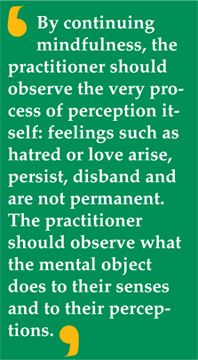|
Lesson for mindfulness – part 3:
Observe the
very process of
perception itself
 Battaramulla Battaramulla
Siri Sudassanarama
sadaham senasuna
Ven. Dr. Mirisse Dhammika thero
 According to the
Visuddhimagga and
Vimuttimagga, moving from the foundation through the extensive evolution of
mindfulness, one has to be aware of his/her own mental objects when he/she
associates with them though the five senses. According to the
Visuddhimagga and
Vimuttimagga, moving from the foundation through the extensive evolution of
mindfulness, one has to be aware of his/her own mental objects when he/she
associates with them though the five senses.
The recommended procedure for observing mental objects (manoarammana) is as
follows: When the practitioner perceives any mental object such as anger,
jealous, hatred, love or compassion, the practitioner is not to dwell upon it in
the ordinary egotistical way. For example,
People have the self-centred perception that whatever their beliefs and
pre-conceived thoughts are, these beliefs and thoughts are considered permanent;
when people apprehend things or other people, pre-settled beliefs or thoughts
such as race, color, friends or enemies will be in the forefront of their mind,
and they will act following those belief and thoughts.
 By continuing mindfulness, the practitioner should observe the very process of
perception itself: feelings such as hatred or love arise, persist, disband and
are not permanent. The practitioner should observe what the mental object does
to their senses and to their perceptions. For example, the ear “processes”
sounds, but it is the mind that creates the reactions of attachment, aversion or
neutrality to those sounds. Instead of holding these reactions as something
objective and permanent, the practitioner should observe the feelings that
arise, and the mental activities that follow. If one becomes attached to
something or someone, love follows this attachment; if one becomes averse, anger
may follow. By continuing mindfulness, the practitioner should observe the very process of
perception itself: feelings such as hatred or love arise, persist, disband and
are not permanent. The practitioner should observe what the mental object does
to their senses and to their perceptions. For example, the ear “processes”
sounds, but it is the mind that creates the reactions of attachment, aversion or
neutrality to those sounds. Instead of holding these reactions as something
objective and permanent, the practitioner should observe the feelings that
arise, and the mental activities that follow. If one becomes attached to
something or someone, love follows this attachment; if one becomes averse, anger
may follow.
One should note the changes in the way one perceives events that occur within
the mind. In watching and observing all these mental phenomena, one must become
aware of one’s own perceptions; our senses contact objects and we feel
attachment or aversion to these objects or we feel neutral about them.
This initial perception will spark pleasant, unpleasant or neutral thoughts. For
example, when I feel love, I am happy; and when I feel fear or pain, I don’t
like it. The understanding that this is common to all people promotes my empathy
for others. This is very important for developing compassion among human beings.
When people follow their feelings, various reactions may arise. They may feel
agreed, desire or jealousy. They may have love, compassion or sympathy. They may
feel fear, worry, restlessness or boredom. The cultivation of compassion instead
of hostility suggests the possibility of consciously directing or shaping our
perception. We simply perceive our feelings, and realize that these arising
feelings are normal human responses and can arise in anybody, and these feelings
are subject to change, they disappear and nothing is permanent . This cognitive
knowledge helps people to prevent negative emotions in their mind. In other
words, this practice helps to attack the root causes of stress, violence,
aggressiveness and disrespect for life that are understood as feelings of anger,
depression, anxiety or helplessness. |
